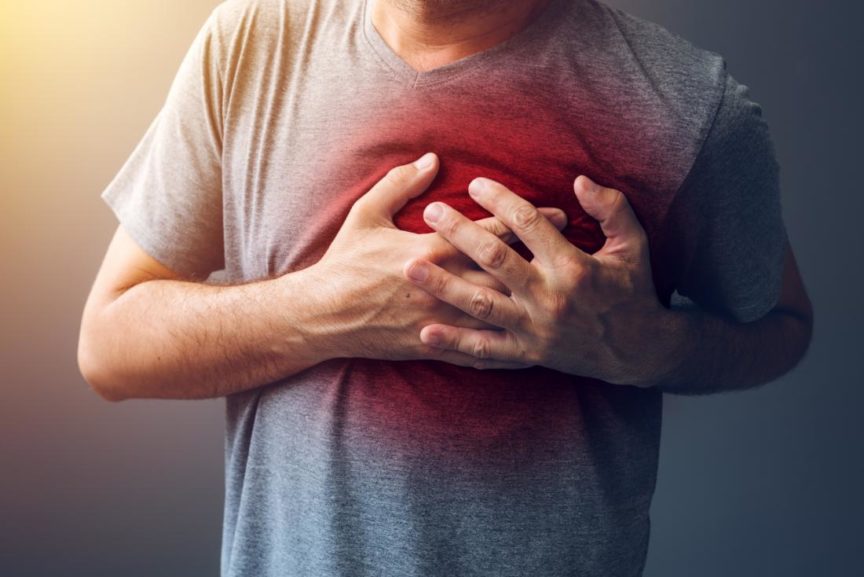Experiencing pain while sneezing is quite common, yet there is very little information available for those facing this issue. I am going to discuss the main reasons why you are experiencing pain in your chest while sneezing/coughing. Having pain in your chest while sneezing is extremely frustrating because you feel helpless, and don’t know what you can do to stop the pain from occurring.
This article discusses primarily pain experienced from sneezing, but you may also experience the same pain in your chest during coughing, certain chest movements, and/or while lifting weights.
People often describe this pain felt during a sneeze as sharp pain or a “pulling feeling” in their chest region. This pain is often felt while they are sneezing, coughing, moving their arms, or during workouts like bench press.
The main cause of this sharp pain during a sneeze is a condition called Costochondritis.
Other less common causes: Pleuritis (inflammation of the lung pleura), or a muscle strain/tear.
You may be asking yourself what is Costochondritis?
 Costochondritis is an inflammation of the cartilage that connects the ribs to the breastbone (sternum). This condition can cause local pain in the chest, and the pain can be reproduced by pushing on the cartilage where the rib connects to the breastbone (sternum). Costochondritis can also be aggravated from sneezing and coughing.
Costochondritis is an inflammation of the cartilage that connects the ribs to the breastbone (sternum). This condition can cause local pain in the chest, and the pain can be reproduced by pushing on the cartilage where the rib connects to the breastbone (sternum). Costochondritis can also be aggravated from sneezing and coughing.
How do you know if you have Costochondritis?
The main symptoms are:
- sharp pain in the front of your chest
- pain during sneezing, coughing, or deep breathes
- tenderness when you press on the rib cartilage
- no pain while at rest
Important to note: Costochondritis can be distinguished from other conditions such as pleuritis, because costochondritis pain can be reproduced when you press on the rib cartilage whereas conditions such as pleuritis will not be tender when you press on it.
How would I get Costochrondritis?
The main cause of costochondritis is repetitive overuse/strain on this cartilage junction where the rib connects to the breatbone (sternum). Anyone can experience costochondritis, but mainly weightlifters and athletes seem to experience costochondritis more often.
Lifting weigh at the gym or at work can cause you to aggravate this cartilage and cause it to become inflamed.
Heavy coughing due to a viral infection (common cold) can also cause costochondritis, due to the heavy coughing causing repeititive stress/strain on this rib cartilage.
Why am I feeling the pain during sneezing?
While sneezing the abdominal/chest pressure increases which produces a drastic force being exerted through the ribcage. So while sneezing this force is exerted on the ribs, and on the cartilage where the ribs attach to breastbone (sternum). So with costochrondritis causing this cartilage to be inflamed, any sudden movements of the ribcage such as sneezing or coughing will cause pain in that area. Due to the inflammation, the area is VERY SENSITIVE so even small forces such as breathing in or a small cough can even cause pain.
What can I do about it?
This can be a quite frustrating injury for people to deal with, because people often ignore it and continue to do the same activities that possibly caused costochondritis, which results in the area not healing or taking a long time to heal. Usually costochondritis heals on its own, and can be managed with rest, physical therapy, braces, and light stretches.
I recommend:
Rest. This is super important for a condition like costochondritis. Rest is vital to reduce the inflammation and allow it to heal. You should avoid all activities that cause pain in that area. Also, when you are going to sneeze or cough try to brace your chest by bear hugging yourself or hugging a pillow. This will help reduce the forces exerted on your ribcage, and it should reduce the pain.
Ice. Use ice to get the inflammation down. Ice every few hours for 15-20 minutes minutes at a time.
Posture. Remember to keep good posture with your shoulders pulled back and your chest tall. There has been some talk about costochondritis being linked to poor posture. Some people believe forward hunched over posture affects the ribcage breathing dynamics, so instead of the ribcage expanding evenly there is extra workload on the front of the ribcage. So the extra workload and stress is causing costochondritis. For example, look at this image. You can see how poor posture can compress the ribcage, and cause poor chest expansion. This could be a main factor contributing to your costochondritis.
Yoga wheel. A yoga wheel/foam roller can be a great way to help open up the front of the ribcage, and provide a deep stretch. Start slowly and stop if this reproduces any of your pain.
Stretches. You should be incorporating some light stretches to open up the front of the ribcage. I recommend laying on an exercise ball and putting your arms out for a deep stretch through your back and ribcage. Another great stretch for costochondritis is a doorway stretch to open up the chest area.
Braces. Back/rib braces can help especially if the injury is in the acute phase (new). Or if you are experiencing sharp pain while coughing or sneezing a brace can be a way to reduce to forces on the ribcage and reduce the pain. I have had a few patients find relief from their costochondritis by using a postural back brace. This postural back brace will help keep your chest opened up by pulling your shoulders back.
Key takeaways
So if you are experiencing sharp pain in your chest while sneezing/coughing then it could be costochrondritis. If the symptoms I described above sounds like what you are experiencing then follow my recommendations to help get rid of costochrondritis.
Costochondritis WILL heal on its own, but be patient, it can take several months for the area to fully heal. Avoid aggravating the area because it will take longer to heal. You can use a postural back brace, yoga wheel/foam roller, and medicine ball to incorporate some light stretches that can help speed up the healing process.
*In MOST cases this problem is benign (not harmful), and will heal on its own. But if what I described above does not fit your symptoms and/or you are still experiencing pain after a couple months, consult with your physician.






